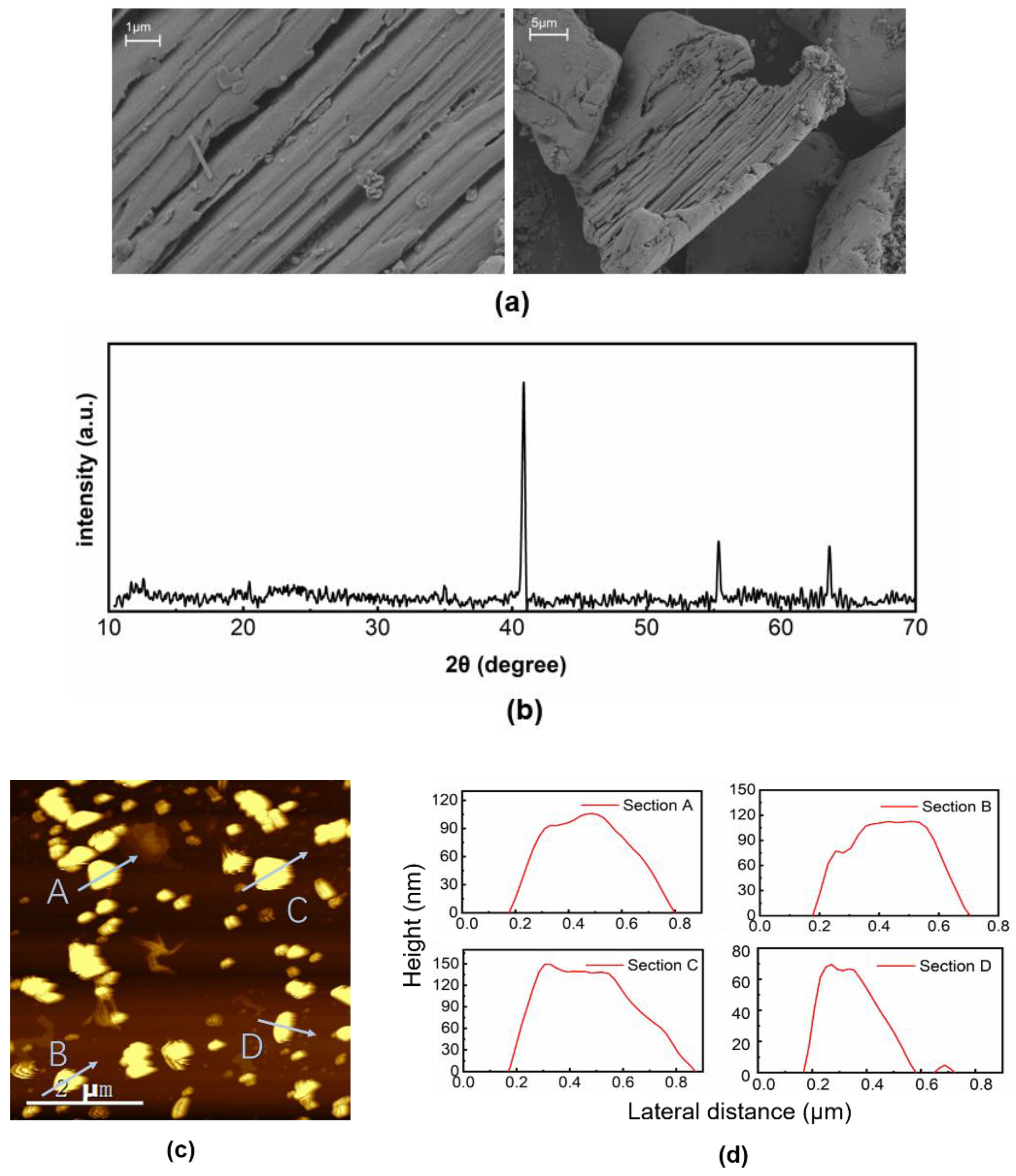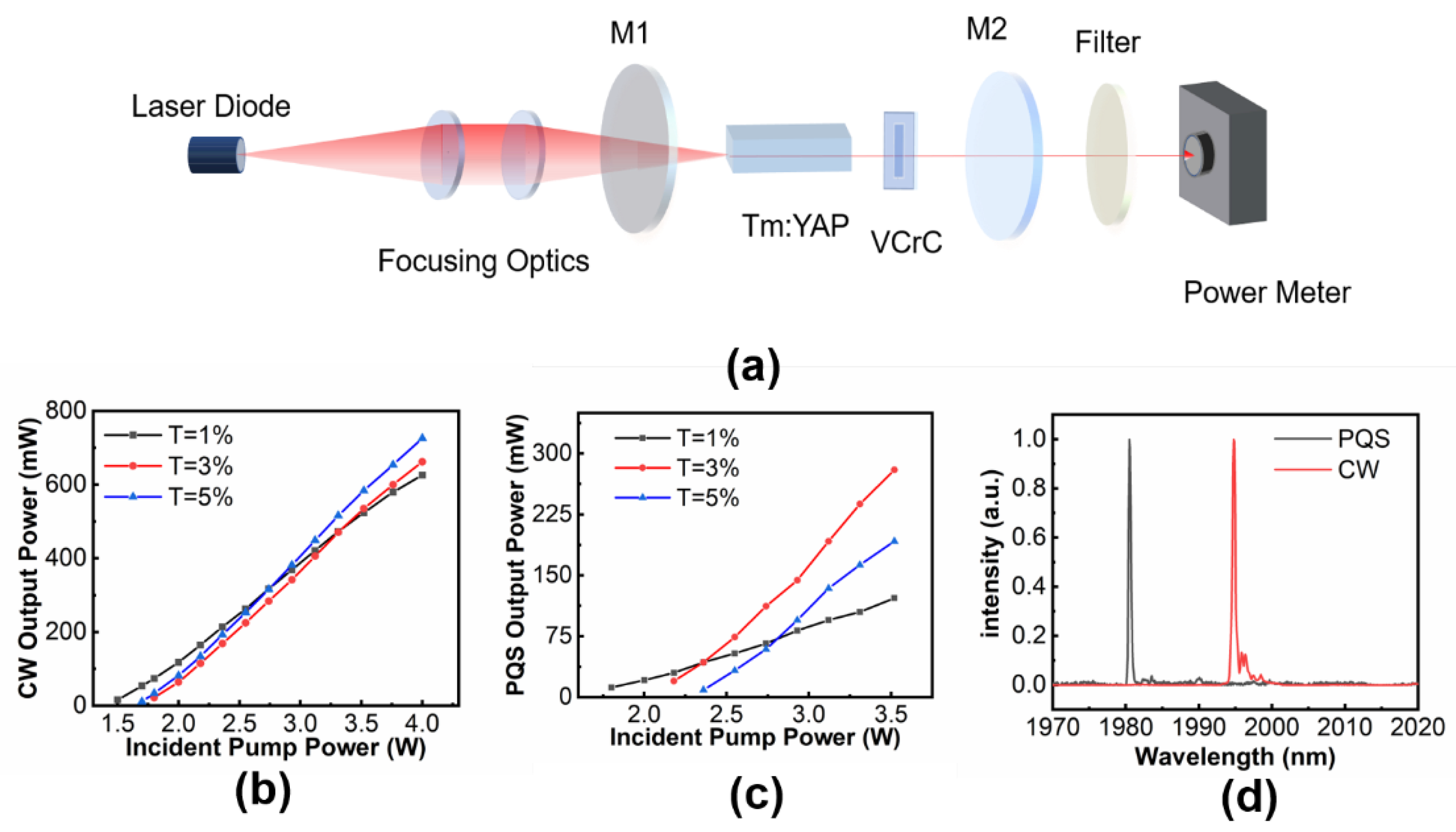Investigation of Nonlinear Optical Modulation Characteristics of MXene VCrC for Pulsed Lasers
Abstract
:1. Introduction
2. Preparation and Characterization of MXene VCrC SA
2.1. Preparation of MXene VCrC SA
2.2. Characterization and Analysis
2.3. Optical Absorption Properties
3. Laser Experiment and Results
4. Conclusions
Author Contributions
Funding
Institutional Review Board Statement
Informed Consent Statement
Data Availability Statement
Conflicts of Interest
Sample Availability
References
- Godard, A. Infrared (2–12 μm) solid-state laser sources: A review. Comptes Rendus Phys. 2007, 8, 1100–1128. [Google Scholar] [CrossRef]
- Yin, T.; Song, Y.; Jiang, X.; Chen, F.; He, S. 400 mW narrow linewidth single-frequency fiber ring cavity laser in 2 μm waveband. Opt. Express 2019, 27, 15794–15799. [Google Scholar] [CrossRef] [PubMed]
- Thomas, M.T.; Dennis, K.K. Development of a tunable, narrow-linewidth, CW 2.066 μm Ho:YLF laser for remote sensing of atmospheric CO2 and H2O. Appl. Opt. 1998, 37, 8460–8476. [Google Scholar]
- Ahmad, H.; Hassan, H.; Safaei, R.; Thambiratnam, K.; Ismail, M.F.; Amiri, I.S. Molybdenum disulfide side-polished fiber saturable absorber Q-switched fiber laser. Opt. Commun. 2017, 400, 55–60. [Google Scholar] [CrossRef]
- Liu, J.; Wang, Y.; Qu, Z.; Fan, X. 2 μm passive Q-switched mode-locked Tm3+:YAP laser with single-walled carbon nanotube absorber. Opt. Laser Technol. 2012, 44, 960–962. [Google Scholar] [CrossRef]
- Liu, X.; Yang, K.; Zhao, S.; Li, T.; Qiao, W.; Zhang, H.; Zhang, B.; He, J.; Bian, J.; Zheng, L.; et al. High-power passively Q-switched 2 μm all-solid-state laser based on a Bi2Te3 saturable absorber. Photonics Res. 2017, 5, 461–466. [Google Scholar] [CrossRef] [Green Version]
- Ma, J.; Xie, G.; Zhang, J.; Yuan, P.; Tang, D.; Qian, L. Passively mode-locked Tm:YAG ceramic laser based on graphene. IEEE J. Sel. Top. Quantum Electron. 2015, 21, 50–55. [Google Scholar]
- Zhang, H.; Lu, S.; Zheng, J.; Du, J.; Wen, S.; Tang, D.; Loh, K. Molybdenum disulfide (MoS2) as a broadband saturable absorber for ultra-fast photonics. Opt. Express 2014, 22, 7249. [Google Scholar] [CrossRef]
- Lu, S.; Miao, L.; Guo, Z.; Qi, X.; Zhao, C.; Zhang, H.; Wen, S.; Tang, D.; Fan, D. Broadband nonlinear optical response in multi-layer black phosphorus: An emerging infrared and mid-infrared optical material. Opt. Express 2015, 23, 11183–11194. [Google Scholar] [CrossRef]
- Niu, Z.; Yang, K.; Li, T.; Zhao, J.; Zhao, S.; Li, G.; Li, D.; Qiao, W.; Chu, H.; Gao, K.; et al. Doubly passively Q-switched Tm:YAP laser with MoS2 and WS2 saturable absorbers at 2 μm. Optik 2019, 198, 163205. [Google Scholar] [CrossRef]
- Lin, M.; Peng, Q.; Hou, W.; Fan, X.; Liu, J. 1.3 μm Q-switched solid-state laser based on few-layer ReS2 saturable absorber. Opt. Laser Technol. 2019, 109, 90–93. [Google Scholar] [CrossRef]
- Zhu, H.; Cai, W.; Wei, J.; Liu, J.; Zheng, L.; Xu, J.; Wang, Y. 763 fs passively mode-locked Yb: Y2SiO5 laser with a graphene oxide absorber mirror. Opt. Laser Technol. 2015, 68, 120–123. [Google Scholar] [CrossRef]
- Jackson, S.D. Singly Ho3+-doped fluoride fibre laser operating at 2.92 μm. Electron. Lett. 2004, 40, 1400–1401. [Google Scholar] [CrossRef]
- Cheng, Y.H.; Tay, B.K.; Lau, S.P.; Kupfer, H.; Richter, F. Substrate bias dependence of Raman spectra for TiN films deposited by filtered cathodic vacuum arc. J. Appl. Phys. 2002, 92, 1845–1849. [Google Scholar] [CrossRef]
- Naguib, M.; Mochalin, V.N.; Barsoum, M.W.; Gogotsi, Y. MXenes: A New Family of Two-Dimensional Materials. ChemInform 2014, 45, 992–1005. [Google Scholar] [CrossRef]
- Gall, D.; Stoehr, M.; Greene, J.E. Vibrational modes in epitaxial Ti1−xScxN(001) layers: An ab initio calculation and Raman spectroscopy study. Phys. Rev. B 2001, 64, 174302. [Google Scholar] [CrossRef] [Green Version]
- Jiang, X.; Kuklin, A.V.; Baev, A.; Ge, Y.; Agren, H.; Zhang, H. Two-dimensional MXenes: From morphological to optical, electric, and magnetic properties and applications. Phys. Rep. 2020, 848, 1–58. [Google Scholar] [CrossRef]
- Huang, H.; Wang, J.; Xu, N.; Liu, S.; Liang, G.; Wen, Q. Ti2CTx MXene as a Saturable Absorber for Passively Q-Switched Solid-State Lasers. Polymers 2021, 13, 247. [Google Scholar] [CrossRef]
- Zu, Y.; Zhang, C.; Guo, X.; Liang, W.; Liu, J.; Su, L.; Zhang, H. A solid-state passively Q-switched Tm,Gd:CaF2 laser with a Ti3C2Tx MXene absorber near 2 µm. Laser Phys. Lett. 2019, 16, 015803. [Google Scholar] [CrossRef]
- Niu, Z.; Feng, T.; Li, T.; Yang, K.; Zhao, J.; Li, G.; Li, D.; Zhao, S.; Qiao, W.; Chu, H.; et al. Theoretical and experimental investigations on Nb2CTx MXene Q-switched Tm:YAP laser at 2 μm for the nonlinear optical response. Nanotechnology 2021, 32, 375709. [Google Scholar] [CrossRef]
- Zeng, Z.; Chen, X.; Weng, K.; Wu, Y.; Zhang, P.; Jiang, J.; Li, N. Computational screening study of double transition metal carbonitrides M′2M″CNO2-MXene as catalysts for hydrogen evolution reaction. npj Quantum Mater. 2021, 7, 80. [Google Scholar] [CrossRef]
- Sheik-Bahae, M.; Said, A.A.; Wei, T.-H.; Hagan, D.J.; Van Stryland, E.W. Sensitive measurement of optical nonlinearities using a single beam. IEEE J. Quantum Electron. 2002, 26, 760–769. [Google Scholar] [CrossRef] [Green Version]
- Zhang, X.; Selkirk, A.; Zhang, S.; Huang, J.; Li, Y.; Xie, Y.; Dong, N.; Cui, Y.; Zhang, L.; Blau, W.; et al. Inside Cover: MoS2/ Carbon Nanotube Core–Shell Nanocomposites for Enhanced Nonlinear Optical Performance. Chem.—A Eur. J. 2017, 23, 3223. [Google Scholar] [CrossRef] [Green Version]
- Huang, J.; Qiao, W.; Li, G.; Yang, K.; Liang, Y.; Li, D.; Li, G.; Feng, T.; Zhao, J.; Zhao, S.; et al. Optical modulation of magnesium 2,5-dihydroxyterephthalate saturable absorber for passively Q-switched 2 μm solid-state laser. Appl. Phys. Express 2020, 13, 11503. [Google Scholar] [CrossRef]
- Chu, Z.; Liu, J.; Guo, Z.; Zhang, H. 2 μm passively Q-switched laser based on black phosphorus. Opt. Mater. Express 2016, 6, 2374–2379. [Google Scholar] [CrossRef]
- Liu, J.; Zhang, C.; Zu, Y.; Fan, X.; Liu, J.; Guo, X.; Qian, X.; Su, L. Efficient continuous-wave, broadly tunable and passive Q-switching lasers based on a Tm3+:CaF2 crystal. Laser Phys. Lett. 2018, 15, 045803. [Google Scholar] [CrossRef]
- Serres, J.M.; Loiko, P.; Mateos, X.; Yumashev, K.; Griebner, U.; Petrov, V.; Aguilo, M.; Diaz, F. Tm:KLu(WO4)2 microchip laser Q-switched by a graphene-based saturable absorber. Opt. Express 2015, 23, 14108–14113. [Google Scholar] [CrossRef] [Green Version]




| SA | Output Power (mW) | Pulse Duration (ns) | Pulse Repetition Rate (kHz) | Single Pulse Energy (μJ) | Peak Power (W) | Reference |
|---|---|---|---|---|---|---|
| MoS2 | 410 | 458.8 | 83.1 | 4.93 | 10.7 | [10] |
| WS2 | 668 | 528.4 | 87.7 | 7.62 | 14.4 | [10] |
| Mg-MOF-74 | 660 | 313 | 117 | 5.6 | 18.0 | [24] |
| BP | 151 | 1780 | 19.3 | 7.84 | 4.4 | [25] |
| Ag-NR | 385 | 3100 | 9.3 | 41.4 | 13.3 | [26] |
| graphene | 310 | 285 | 190 | 1.6 | 6 | [27] |
| Ti3C2TX | 208 | 2390 | 19.6 | 10.61 | 4.44 | [19] |
| Nb2CTX | 623 | 1960 | 80 | 7.78 | 3.97 | [20] |
| VCrC | 280 | 865.3 | 49 | 5.7 | 6.6 | this work |
Publisher’s Note: MDPI stays neutral with regard to jurisdictional claims in published maps and institutional affiliations. |
© 2022 by the authors. Licensee MDPI, Basel, Switzerland. This article is an open access article distributed under the terms and conditions of the Creative Commons Attribution (CC BY) license (https://creativecommons.org/licenses/by/4.0/).
Share and Cite
Meng, Y.; Liu, Y.; Li, T.; Feng, T.; Huang, J.; Ni, Z.; Qiao, W. Investigation of Nonlinear Optical Modulation Characteristics of MXene VCrC for Pulsed Lasers. Molecules 2022, 27, 759. https://doi.org/10.3390/molecules27030759
Meng Y, Liu Y, Li T, Feng T, Huang J, Ni Z, Qiao W. Investigation of Nonlinear Optical Modulation Characteristics of MXene VCrC for Pulsed Lasers. Molecules. 2022; 27(3):759. https://doi.org/10.3390/molecules27030759
Chicago/Turabian StyleMeng, Yao, Yizhou Liu, Tao Li, Tianli Feng, Jiacheng Huang, Zheng Ni, and Wenchao Qiao. 2022. "Investigation of Nonlinear Optical Modulation Characteristics of MXene VCrC for Pulsed Lasers" Molecules 27, no. 3: 759. https://doi.org/10.3390/molecules27030759
APA StyleMeng, Y., Liu, Y., Li, T., Feng, T., Huang, J., Ni, Z., & Qiao, W. (2022). Investigation of Nonlinear Optical Modulation Characteristics of MXene VCrC for Pulsed Lasers. Molecules, 27(3), 759. https://doi.org/10.3390/molecules27030759





